List of governors of the Habsburg Netherlands
From Wikipedia, the free encyclopedia
The governor (Dutch: landvoogd) or governor-general (gouverneur-generaal) of the Habsburg Netherlands was a representative appointed by the Holy Roman emperor (1504-1556), the king of Spain (1556-1598, 1621-1706), and the archduke of Austria (1716-1794), to administer the Burgundian inheritance of the House of Habsburg in the Low Countries when the monarch was absent from the territory. The role of the governors-general significantly changed over time: initially tutors and advisors of Emperor Charles V, who lived at the Palace of Coudenberg, they served as generals during the Eighty Years' War between the Kingdom of Spain and the Dutch Republic. Frequently, the governor-general was a close relative of the Austrian or Spanish monarchs, though at other times Spanish or German noblemen filled the role. The governor-general was usually based in Brussels.
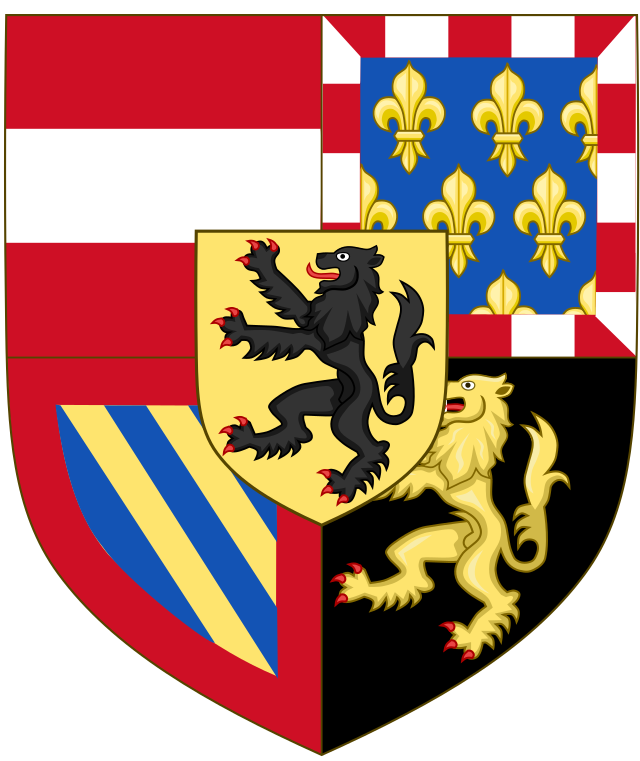
List of governors
Summarize
Perspective
| Picture | Name | Took office | Left office | Relationship to monarch | Appointed by |
|---|---|---|---|---|---|
 |
Engelbert II of Nassau (1451–1504) |
1501 | 1504 | / | |
 |
William de Croÿ (1458–1521) |
1504 | 1507 | / |   Maximilian I for Charles of Ghent Maximilian I for Charles of Ghent |
 |
Margaret of Austria (1480–1530) |
1507 | 1 December 1530 (death) |
Aunt of Charles | |
| Charles became Duke of Burgundy in 1506 (emancipated in 1515), King of Spain and the Two Sicilies in 1516, Archduke of Austria and Holy Roman Emperor as Charles V in 1519 at the death of Maximilian. | |||||
 |
Mary of Austria (1505–1558) |
January 1531 | October 1555 | Sister |  Charles V, Holy Roman Emperor Charles V, Holy Roman Emperor |
 |
Emmanuel Philibert of Savoy (1528–1580) |
1555 | 1559 | Cousin of Philip |   Charles V for his son Philip. Charles V for his son Philip. |
| In 1556, Philip V, Duke of Burgundy, became king of Spain as Philip II, thereby bringing the Habsburg Netherlands under Spanish control. | |||||
 |
Margaret of Parma (1522–1586) |
1559 | 1567 | Half-sister | |
 |
Fernando Álvarez de Toledo, 3rd Duke of Alba (1507–1582) |
1567 | 1573 | / | |
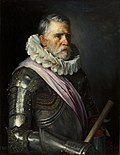 |
Luis de Requesens y Zúñiga (1528–1576) |
1573 | 5 March 1576 (death) |
/ | |
 |
John of Austria (1547–1578) |
1576 | 1 October 1578 (death) |
Half-brother | |
 |
Alexander Farnese, Duke of Parma (1545–1592) |
1578 | 3 December 1592 (death) |
Half-nephew | |
 |
Peter Ernst I von Mansfeld-Vorderort (1517–1604) |
1592 | 1594 | / | |
 |
Ernest of Austria (1553–1595) |
1594 | 20 February 1595 (death) |
Nephew | |
 |
Pedro Henriquez de Acevedo, Count of Fuentes (1525–1610) |
1595 | 1596 | / | |
 |
Albert of Austria (1559–1621) |
1596 | 1598 | Nephew | |
| In 1598, Philip II of Spain ceded the Netherlands to his daughter Isabella Clara Eugenia and nephew Albert, who married the next year. They reigned together until his death, when the Netherlands passed to their nephew, Philip IV of Spain, in whose name Isabella Clara Eugenia governed the countries until her death. | |||||
 |
Isabella Clara Eugenia of Austria (1566–1633) |
1621 | 1 December 1633 (death) |
Aunt | 
|
 |
Ferdinand of Austria (1609/1610–1641) |
1633 | 9 November 1641 (death) |
Brother | |
 |
Francisco de Melo (1597–1651) |
1641 | 1644 | / | |
 |
Manuel de Moura (1590–1651) |
1644 | 1647 | / | |
 |
Leopold William of Austria (1614–1662) |
1647 | 1656 | Cousin | |
 |
John of Austria the Younger (1629–1679) |
1656 | 1659 | Son | |
 |
Luis de Benavides Carrillo (1608–1668) |
1659 | 1664 | / | |
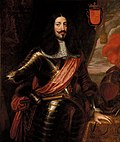 |
Francisco de Moura (1610–1675) |
1664 | 1668 | / | |

| |||||
 |
Íñigo Melchor de Velasco (1608–1668) |
1668 | 1670 | / | |
 |
Juan Domingo de Zuñiga y Fonseca (1640–1716) |
1670 | 1675 | / | |
 |
Carlos de Aragón de Gurrea (1634–1692) |
1675 | 1677 | / | |
 |
Alexander Farnese (1635–1689) |
1678 | 1682 | Second Cousin | |
| Ottone Enrico del Caretto (1629–1685) |
1682 | 1685 | / | ||
 |
Francisco Antonio de Agurto (1640–1702) |
1685 | 1692 | / | |
 |
Maximilian II Emanuel of Bavaria (1662–1726) |
1692 | 1706 | Nephew-in-law | |
| Uncle |  Philip V of Spain Philip V of Spain | ||||
 |
Isidoro de la Cueva y Benavides (acting) (1652–1723) |
1701 | 1704 | During the absence of Maximilian of Bavaria | |
| Following the War of the Spanish Succession, Holy Roman Emperor Charles VI became ruler of the Austrian Netherlands. | |||||
 |
Eugene of Savoy (1663–1736) |
1716 | 1724 | Third cousin |  Charles VI, Holy Roman Emperor Charles VI, Holy Roman Emperor |
 |
Wirich Philipp von Daun (1669–1741) |
February 1725 | October 1725 | / | |
 |
Maria Elisabeth of Austria (1680–1741) |
1725 | 26 August 1741 (death) |
Sister | |
| Aunt |  Maria Theresa of Austria Maria Theresa of Austria | ||||
 |
Friedrich August von Harrach-Rohrau (1696–1749) |
1741 | 1744 | / | |
 |
Maria Anna of Austria (1718–1744) |
1744 | 16 December 1744 (death) |
Sister | |
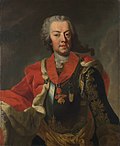 |
Charles Alexander of Lorraine (1712–1780) |
4 July 1780 (death) |
Brother-in-law | ||
 |
Maria Christina of Austria-Lorraine (1742–1798) with Albert Casimir of Saxony (1738–1822) |
1781 | 1793 | Sister and brother-in-law |  Joseph II, Holy Roman Emperor Joseph II, Holy Roman Emperor |
 Leopold II, Holy Roman Emperor Leopold II, Holy Roman Emperor | |||||
| Aunt and uncle |  Francis II, Holy Roman Emperor Francis II, Holy Roman Emperor | ||||
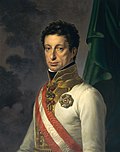 |
Charles of Austria-Lorraine (1771–1847) |
1793 | 1794 | Brother | |
Thereafter, the French revolutionaries occupied the Low Countries until 1815. The Emperor formally recognized the loss of these territories by the Treaty of Lunéville of 1801. At the Congress of Vienna, in 1815, the Low Countries were re-united in a personal union under the House of Orange-Nassau. In 1830, Belgium declared its independence.
See also
Wikiwand - on
Seamless Wikipedia browsing. On steroids.

